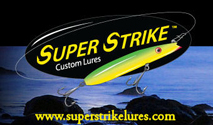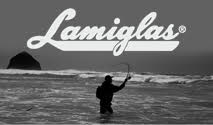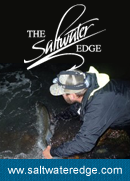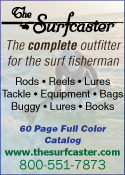THE CHESAPEAKE CHRONICLES – Part 3
by Rich Troxler aka RichTrox
Well it’s been awhile since I updated this running narrative on my new area, Chesapeake, VA, but I have a few minutes now so let me get at it. Most of this edition will focus on how different a fish the striped bass is down here, from the fish I know and love from up north. After 40 years of fishing for striped bass up north, I’ve developed certain mindsets about this fish. When I lie in bed at night thinking about fishing for striped bass, the images I see in my mind’s eye come from the thousands of nights spent jacking fish from the bridge tops, slinging eels off back bay points, or at channel drops, bucktailing inlets, or launching chunks of fresh bunker or one of my small selection of go-to plugs into the surf of Long Island’s south shore.
None of that prepared me for how different a fish the striped bass is down here. Up north, the striped bass is the primary glamor species, the top dog, the object of desire by most all who fish the surf. But not so down here. While northern Virginia and what’s known as the “eastern shore” has a somewhat more focused fishery from the surf for striped bass, once you cross the 17 miles of the Chesapeake Bay Bridge Tunnel (CBBT), that all but disappears.
Yes, the boat guys have their short run of big fish in the fall, along the lights of the CBBT or floating eels under big bobbers on the flats at the mouth of the bay, but those fish don’t stay long before moving off to the coast of North Carolina. But even that hasn’t been great since I’ve moved here. There are also some boats that pursue them up the Potomac when they come in to breed, but that pretty much sums up the focused fishery for large striped bass. In my neck of the woods, there is little effort from the beach and not a whole lot of expectation on landing anything approaching a 30 or better. For now, catching big striped bass from the surf is something that exists only in my memory.
So while up north the striped bass is held in high esteem, down here it’s just another fish and in some instances, even considered a nuisance fish. During the colder months of the year, there is a very concerted fishery up in the James River, and several other rivers, for big Blue Catfish. These fish can crack 100 lbs and are highly sought after as a game fish. Blue Catfish like to hang around channels drops and in deep holes, not unlike the striped bass, and there are large striped bass that do winter over in these same rivers. The catfish anglers have been known to be highly annoyed when a 30 lb bass eats their nice fresh chunk of gizzard shad meant for a blue cat. Imagine being pissed at catching a 30 lb striper!
While you don’t catch a lot of large striped bass down here, or to be more accurate, the time to catch them is very short, there are fairly long seasons for catching big bull reds (to 50+ inches) and even bigger cobia (60 lbs), two of the glamor species down here. And if it’s size you want, there are plenty of black drum over 80 lbs, but that’s more of a boat gig. The prime surf season for reds is in the fall, around October, but they are in the Chesapeake Bay all summer and can show up anywhere at any time, and cobia are being caught at the time of this writing, from both boat and dock. There are also many other species available down here, but that’s another story for another time, so let’s get back to the striped bass.
So while I’ve thus far painted a somewhat bleak picture regarding the striped bass fishery down here, it really speaks to how different my expectations were when I moved down here, when measured against the reality of their life-cycle and the role they play in the ecosystem of this area. They are an amazing and resilient fish.
Actually, striped bass are quite ubiquitous down here, it’s just that they exist in a completely different paradigm than what I am used to, given my 40 years on Long Island. Most anybody who has fished for them know that striped bass are anadromous, meaning they are born in fresh water but live most of their adult life in the briny. In many, many places they have been stocked into lakes where they live their entire lives, so they basically can live in any water. And so it is down in these parts, as there is no shortage of rivers, back bays, lakes with river connections, canals, fresh water, brackish water and good old salt water. And they all hold bass at one time or another, and very odd times at that.
I’ve done a little research during my time here and the one thing that jumped out at me is that the striped bass down here spend their first 4 or so years in the brackish waters they were born in. Sometime in their 5th year or so they start to venture out to the salt water and begin their adult life. And even as early adults, they will wander in and out between fresh and salt water. So as always, striped bass are where you find them.
From the time I moved here 2 ½ years ago up until now, I’ve tended to look for striped bass in areas that are familiar to me. There’s Lynnhaven inlet, which has a bridge over it’s expanse, Broad channel which empties into said inlet, Little Creek Inlet, Rudee Inlet, and several others. The common denominator with all of these places is salt water, fast and deep, with structure of some kind, basically conditions I recognize and associate with the striped bass as I knew it.
And I’ve caught plenty of fish in these places, just nothing to write home about in terms of size. You catch a 30” or 32” and everybody down here gets really excited, and they really lose their minds when you casually toss it back lol. So in terms of catching fish, my transferrable skills from up north have served me well enough down here, and in some cases have allowed me to excel when others have not fared so well.
In addition to all I’ve had to learn, and continue to learn down here, it’s been really interesting observing the differences in fishing culture, where catching striped bass are concerned, and there are some really bizarre differences. As we all do in our own lives, people get stuck on ways to do things, and it’s no different with fishing. I came down here with my own expectations on how I would catch striped bass and the people down here have theirs, and we can both benefit from each other’s viewpoint. And sometimes it makes for a good laugh.
Case in point, the happy clam. Nobody, and I mean NOBODY fishes clam for striped bass down here. They’ve never heard of such a thing! To expand my fishing range I purchased a kayak two seasons ago. This allows me to drift the bridge pilings at Lynnhaven inlet, as well as the inlet proper. So last fall I decide to drift some salted surf clams from a simple 3-way rig with a circle hook. It’s stupid easy fishing.
You paddle uptide of the bridge, lob the clam rig out in front of the yak, hit bottom, lock the reel and stick the rod in the holder. I don’t know how others do it, but I drift backwards with the paddle in my hands and maneuver the kayak so I drift with the current close to the pilings. When I pop out the other side I drift a little further down the channel before reeling in and paddling back up to drift another set of pilings. Because it’s a circle hook, the fish hook themselves.
On my way to the inlet I stopped at Ocean’s East II to pick up some clam. Ocean’s East II is a really large B&T, I mean they have EVERYTHING, including a lot of local knowledge and very helpful (most times) employees. I asked the young man behind the counter if they have any fresh salted clam and he looked at me like I’m from Mars.
“Salted clam?’
“Geez mister, I don’t think we carry it. We got frozen clam though, over there, in the freezer.”
I went to the freezer he pointed to and pulled out two packs of frozen clam and headed back to the counter to check out. Just for shits and giggles, I asked if these had been salted before freezing and again, I got the deer in the headlights, what do I tell the man from Mars look lol.
“No sir, I don’t believe they have been.”
So I figured I’d throw this poor guy a bone and explained to him that salting clam with kosher salt toughens the meat and makes the clam stay on the hook better. He said he had never heard about anybody doing that before, thanked me sincerely for the information, and seeing as we were getting all chummy and whatnot he popped the $64.00 question.
“So whad’re you gonna fish for?”
“Striped bass” I replied while stuffing my change in my wallet.
“Striped bass! You won’t catch no striped bass with clam, that’s for croaker and spot, you want to get some shedder crab if you’re gonna be fishing for rockfish.”
Again, the man from Mars look was back and it was all I could do to keep from laughing. I assured him that I would have little problem catching rockfish with clam, that they actually loved the **** things, but that I would try shedder crab one day. This time I thanked him for his information and bid him good day.
I finally get down to the launch on Crab Creek and from the number of vehicles parked there, I could see it was going to be a busy day, especially for a weekday. I immediately soaked the frozen clam to get it thawed while I readied my kayak and gear. The clam thawed quickly and in 15 minutes I was on my out, rounding the point and paddling against the building current, up toward the bridge.
As I neared the bridge I could see several kayaks working the various spans. As I paddled closer, it looked like those closest to me were throwing rubber baits on jig heads, either for fluke (called flounder down here) or for striped bass. I picked a span that nobody was working and as I passed the others, we exchanged the usual head nods and waves.
I reached my starting point just as the incoming current started pushing pretty good. The first several drifts were uneventful, just the ever present pecks of small croaker, slowly stealing my clam. On maybe the 4th or 5th drift, just as I was drifting past the last couple pilings of the span I was fishing, I noticed the croaker pecks stopped. 4 or 5 seconds later the rod bends and I’m on.
As I cleared the last piling I pulled the rod out of the holder and resisting the old urge to set the hook, simply started reeling in the fish. After a short spirited fight I pulled a chunky bass around 24” onto my lap. I quickly unhooked and released the bass, threaded another clam belly onto the hook, and paddled back up quickly before anybody else had a chance to jump my drift. My catch had not gone unnoticed.
This drift was a repeat of the previous drift except the fish was a few inches bigger. Two fish in a row was more than the other kayak spectators could handle. People are very friendly down here, so we all tend to talk to each other with very little of the fishing snobbery I’ve witnessed up north, except some of the pier guys lol.
As I paddled back up, two kayaks, one on either side, started to close the distance to me. The guy on my left, who I had seen there, and spoken to, several times before was the first to pull up.
“Nice going man, looks like you got the hot hand today” he said as his eyes scanned my rod for clues as to what bait I using.
“So far, so good, they’re right where they’re supposed to be” I said, while letting him look at the bare circle hook.
Finally his curiosity got the best of him.
“So what are you throwing that they’re lov’in so much?”
I reached into my small cooler and pulled out the open bag of clam.
“Clam”
There it was again. The man from Mars look, only this time with a smile. By this time, the kayak on the right had arrived and our happy little raft up was drifting away from the bridge back into the bay.
“Are you ****’in me” he said laughing.
Looking over at the other kayak fisherman, who I come to find out is his good friend, he says:
“He’s telling me he caught those rocks on clams”
Then:
C’mon man, you’ve seen me here before, I’ve given you info before, what are y,….
I put my hand up to stop him and told him that I was telling the truth and that he could watch me do it again. I put a clam on the hook and as we started to make our way back to the bridge, I explained the rig to them and told them that I couldn’t believe that they never heard of fishing clams for striped bass.
As if to make a liar out of me, the fishing gods saw to fit make me wait several more drifts before sending a bass my way. It went off without a hitch. We were drifting with me to the inside of the pilings and about halfway through the span, my rod bends over. I back paddle out from the pilings and pull the rod from the rod holder and reel the fish in. It was just another schoolie but to them it was like producing the Holy Grail. I caught several more bass, all cookie cutter schoolies, before the incessant pecking of croaker caused me to run out of clam and ended my afternoon.
So that was a result of applying striped bass fishing, as I know it, to areas that look familiar to me, under conditions that I’m familiar with, and using techniques that I’m familiar with. But there is so much more to learn because there are so many other places they inhabit down here. And again, the fishing culture is almost alien to me.
Take plugs for instance. Nobody uses redfins, bombers, SP minnows (the north’s new hot plug) and the like down here. The big plug down here is the Mann’s Stretch 20. Want to catch rockfish, troll a Stretch 20, fresh or saltwater lol. Bait for rockfish, shedder crab or live eels. Stop the press, fresh bunker is hard to get down here, it’s all vacuum packed frozen stuff, and most don’t even use it for bass bait. The one thing the north and here have in common is jig heads and rubber bodies. They’re used a lot down here.
The other thing I have to get used to is the fresh water side of striped bass. I am constantly surprised at where these fish show up. This spring I took my kayak up to one of a group of large fresh water impoundments known collectively as “The Suffolk Lakes” to do some largemouth fishing. All of these lakes feed into the Nansemond River which joins the much bigger James River at the mouth of the bay. The largemouth bass were done spawning and I was focusing on the edges where the nesting flats dropped off into deeper water. I was covering water, throwing a stick bait and connecting regularly. There are some beautiful lakes down here, I will say that.
I make a cast and start my twitch retrieve when I get a solid double bump. I set the hook and immediately the fish starts taking line. I’m grinning like an idiot thinking I have a 10 lb largemouth on the other end, so you can imagine my surprise when after a few more minutes I work the fish in range and see stripes! That was the last thing I would have expected to see in that location.
It was the only one I caught that day, but after some investigation, it turns out that not only was that fairly common, there is actually a fishery for them during the colder months, in several of those lakes. And they’re not stocked there, they just wander in from the Nansemond river following threadfin shad most likely. And the kicker is that teen sized fish are not all that uncommon in those lakes. Just make sure you’re trolling a Mann’s Stretch 20 lol.
It’s same thing from all the major rivers, their brackish smaller bays that dot the shoreline of the greater Chesapeake Bay, the smaller feeder rivers, the lakes connected by canals and channels, right on down to North Carolina and the back bay waters of the Currituck Sound. Those resident younger fish are pretty much everywhere and many of these locations get shots of larger fish at certain times of the year and under certain conditions.
And therein lies the task for me, to figure out the game within the game down here, at least where catching striped bass are concerned. I’ll never land the size fish I routinely caught up north, at least not with any regularity from shore, but I’ll supplant other fish like redfish, to fill my need for big fish. In the meantime, catching schoolie sized stripers on scaled down tackle, sometimes in locations where I least expect them, is helping to keep me connected to a fish that has been an important part of most of my adult life. They are tough little buggers and are worthy of respect.
Editor’s note
50% OFF this week SJ “Wave” t-shirt in our online store
Use coupon code “50%OFFWAVE”
www.surfcastersgear.com


















 No, we didn’t get jack sh*t that night, but it felt good to be back in the game – a big fish spot, a VS300 matched with a Kennedy Fisher rod – more than capable of turning a big fish in that wicked Moriches current. And it felt good to be suffering a little as we hopped along the rocks like a pair of mountain goats.
No, we didn’t get jack sh*t that night, but it felt good to be back in the game – a big fish spot, a VS300 matched with a Kennedy Fisher rod – more than capable of turning a big fish in that wicked Moriches current. And it felt good to be suffering a little as we hopped along the rocks like a pair of mountain goats.



